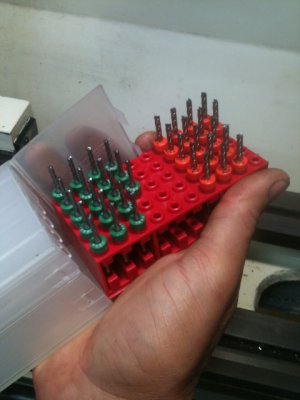-
Welcome back Guest! Did you know you can mentor other members here at H-M? If not, please check out our Relaunch of Hobby Machinist Mentoring Program!
You are using an out of date browser. It may not display this or other websites correctly.
You should upgrade or use an alternative browser.
You should upgrade or use an alternative browser.
Noob milling, speed and feed, technique mentors needed
- Thread starter shorton
- Start date
- Joined
- Feb 8, 2014
- Messages
- 11,145
Does it make sense to think in terms of the cross-sectional area of the metal being removed? For example, if I can take a 1/16" deep full width cut with that 1/8" cutter, can I take a 1/8" deep cut if I am taking a 1/16" wide bite?
The short answer is generally yes.
You normally want to do a maximum step over of about 45% of the diameter. Therefore, 0.125 * .045 = 0.0562. That way you are not quite to the end mill center. A lot of machining is all about feel. With a little practice you can feel when the machine and cutter are happy.
I generally machine a bit on the conservative side, so it takes me a bit longer remove material, but normally I do one off jobs so I am not worried about high production rates, especially when I'm working on a job for myself. When I did run the job I mentioned in my post above, I did optimize the feed rates to the limits of my machine and tooling.
- Joined
- Dec 8, 2013
- Messages
- 2,651
NO, taking a 1/8 DOC with a 1/16 end mill will put much more load on the smaller end mill. You would be putting twice the load on a mill that is half the diameter and that is a recipe for breakage.
Not a 1/16" end mill. A 1/8" end mill taking a 1/16" bite out of the side of a slot or pocket, for example. In other words, if only half of the diameter of the cutter is engaged can I go a full diameter deep?
- Joined
- Apr 6, 2011
- Messages
- 2,082
I use a neat little program called HSMAdvisor quite a bit to work out initial speeds and feeds, especially when I'm doing something a little "exotic".
http://hsmadvisor.com/
-Ron
http://hsmadvisor.com/
-Ron
- Joined
- Nov 16, 2012
- Messages
- 5,596
Just so you know, these smaller endmills break pretty easy. There's a reason they come in packs of 25 and 50....

If you don't have a machine with 5000 RPM capability, when you get below 3/8" diameter, everything you do is a tradeoff anyhow. You might want to consider doing some practice cuts with say, a 3/8 or 1/2" EM. A lot more forgiving... And FWIW, I'm perfectly fine with machines that don't go so fast. I've never known anyone with a "normal" mill whose had to replace their bearings or spindle whereas, I can't shake a stick at all the people I'm aware of whose had to replace their 5000+ RPM bearings and spindle... Heck, I know of a couple people who carry spares.
Anyhow, I view EMs 1/4" and under as more of a drillbit than anything else. 5/16 is marginal for real milling. I know we're talking about manual machining here but, the issue of HSM (High Speed Machining) is always raised as soon as you mention a feed & speed chart. I've never seen a S&F chart that wasn't oriented toward HSM.
The upshot of what I'm getting at is: With manual machining, you've got all the latitude in the world. If you have table power feed, you still can't do true HSM and you shouldn't really be trying to. With table feed, you set your RPMs to the closest desired value then, adjust table speed until you get a cut that feels, sounds and works good. -That is as far from HSM procedures as your going to get.
The upshot here, is the discussion about F&S needs to be delineated between manual/casual machining and HSM -and furthermore, the procedures with EMs below a certain diameter fall into a category of their own.
Ray


If you don't have a machine with 5000 RPM capability, when you get below 3/8" diameter, everything you do is a tradeoff anyhow. You might want to consider doing some practice cuts with say, a 3/8 or 1/2" EM. A lot more forgiving... And FWIW, I'm perfectly fine with machines that don't go so fast. I've never known anyone with a "normal" mill whose had to replace their bearings or spindle whereas, I can't shake a stick at all the people I'm aware of whose had to replace their 5000+ RPM bearings and spindle... Heck, I know of a couple people who carry spares.
Anyhow, I view EMs 1/4" and under as more of a drillbit than anything else. 5/16 is marginal for real milling. I know we're talking about manual machining here but, the issue of HSM (High Speed Machining) is always raised as soon as you mention a feed & speed chart. I've never seen a S&F chart that wasn't oriented toward HSM.
The upshot of what I'm getting at is: With manual machining, you've got all the latitude in the world. If you have table power feed, you still can't do true HSM and you shouldn't really be trying to. With table feed, you set your RPMs to the closest desired value then, adjust table speed until you get a cut that feels, sounds and works good. -That is as far from HSM procedures as your going to get.
The upshot here, is the discussion about F&S needs to be delineated between manual/casual machining and HSM -and furthermore, the procedures with EMs below a certain diameter fall into a category of their own.
Ray


